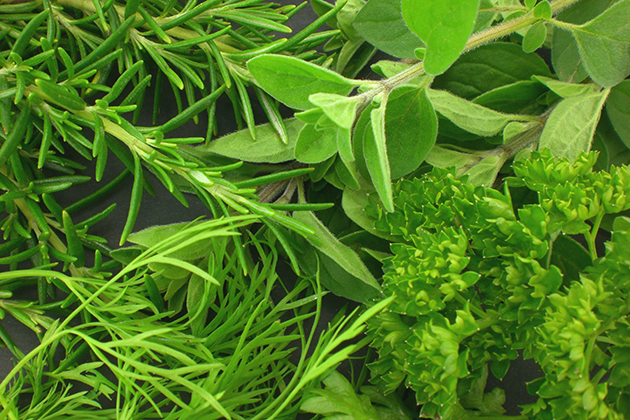Testing herbs as active ingredients in food production

Herbs are a well-known flavouring used in cooking and they have also been used for centuries in a medical context. But what happens if the active ingredients in herbs are also used during food production? Could the health of chickens and salmon be improved if they were given a bit of yarrow and rosemary?
Nofima is now embarking on a real “out of the box” research project. that will take known technology and knowledge into new areas. Consequently in a few years time herb farmers may be able to help to improve the animal welfare of both farmed salmon and chickens. Or food products in the shops could last longer in more environmentally friendly packaging.
BioACTive
“Bio-forming for bioactive compounds ‒ bioACTive” is the name of a project that launched in 2021, and which has received a grant of NOK 11.7 million over three years from the Research Council of Norway. The project stands out as a small grab bag of ingredients and partners.
“The project appears very diverse,” admits Jan Thomas Rosnes, a senior researcher at Nofima who will be heading the project. In addition to Nofima the other participants are the Norwegian Institute of Bioeconomy Research (Nibio), the Norwegian Veterinary Institute, PlantChem AS, Skretting Arc., Norgesfôr AS, Frøvoll gård and Bosheimsmarken AS. The Institute of Macromolecular Chemistry in Iasi, Romania, is also involved.
“The intention is for the bioACTive results to be used in many different contexts in society, and the amazing thing is that is actually the scope of the project and our “out of the box” thinking that received top scores from the Research Council in respect of advertising relevance. This is a Competence and Collaboration Project (KPS) under which research and development expertise will be extending out beyond the usual boundaries, something which the Research Council clearly wants,” says Mr. Rosnes. He adds:
“We will find new biotechnology applications and look at how we can use biotechnological knowledge across different disciplines. This project fits in well with the Government’s ideas on bio-economy,” Rosnes states.
Optimising cultivation
Herbs are the project’s key ingredient. Norway has advantages in respect of cultivating herbs because it has excellent, clean cultivation conditions and space for growing a lot of herbs on open ground. Nibio will be testing to see how we can achieve increased value added in respect of this particular type of plant production. The researchers will also find out which substances can be extracted from the various herbs and how they can be used in biotechnology. The researchers are especially looking for antioxidants, bactericides and anti-inflammatory substances. These are substances which the herbs produce naturally.
“Herbs have been known to have positive medicinal effects since time immemorial. We will now be looking at how actual cultivation can be optimised in a sustainable way. We will then go into the laboratory and check which herbs have attractive properties and how those can work in different areas. Finally, the most promising herbs will be tested in animal experiments in order to see if, by adding herbal extracts to animal feed, we can achieve better health and resistance to disease.”
“The diseases we will be looking at in this project are intestinal diseases in chickens and what are referred to as winter ulcers in salmon, etc. Ulcers in salmon occur during the first year after they are released into the sea, resulting in a high rate of mortality,” explains Mr. Rosnes.
He says that it is already known that the feed industry uses herbs as health-promoting ingredients in various contexts, but obviously they do not advertise their own recipes. There is considerable interest among seafood producers to further reduce the use of antibiotics, and instead use natural additives in feed that can prevent disease and other problems.
Could extend shelf-life
Furthermore, technology now exists which makes it possible to transfer the positive properties of herbs into food packaging in order to increase shelf-life and possibly maintain existing shelf-life in more environmentally friendly packaging materials. Another goal is also to find out how the active ingredients in the herbs can increase shelf-life without adding taste to the food.
“Our overall goal is to document added values and encourage the industry to use more of these natural herbal products. Herb cultivation is something that can be done locally in Norway’s regional areas and on a small scale. In this project we will be testing nine different herbs: oregano, yarrow, peppermint, hops, rose root (Rhodiola rosea), Maral root (Rhaponticum carthamoides), sweet wormwood, common purslane and rosemary. The most promising extracts from these will be tested against the various objectives of the project,” explains Mr. Rosnes.
This research project is divided into six work packages, with separate managers and academic groups associated with each package. The different work packages are: herbal cultivation, screening and extraction of the active ingredients in the herbs, herbs for fish feed for acting on fish health, herbs for chicken feed for acting on chicken health, herbs as bacterial inhibitors in food packaging/packaging technology and finally a work package involving communication and commercialisation.
“Such complexity means that frameworks will be set up for the project, but we want to understand how we can make better use of these herbs and encourage increased local production. The aim of the project is to develop socially positive solutions for using herbs in various areas. And hopefully we will find more opportunities than those currently envisaged,” says Jan Thomas Rosnes.
Contact person
Topics
Fish feed